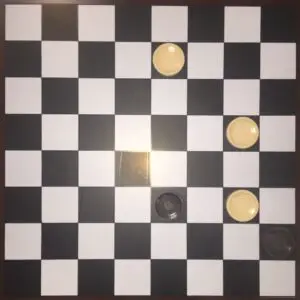
While checkers (draughts) is an easy game to learn, the popular saying about “playing chess not checkers” minimizes the amount of checkers strategy and tactics that go into playing well.
This becomes obvious when you play against someone who beats you every time. They clearly know how to win checkers. There’s more than just setting up the board, knowing the rules, and moving pieces randomly.
Checkers Strategy: How to Win
Checkers is a pure strategy game where you control every move you make, as your opponent does his, so it makes sense that there are many principles of strong play.
If you want to learn how to win checkers, you’re in the right place. This article will look at general checkers strategy, tactics and tips.
Checkers Strategy & Tips
Here are some general checkers strategies that often lead to strong moves. Be aware that you can’t blindly follow these principles. You still have to consider the position on the board.
Sometimes, doing the opposite will be the best. As you play and gain experience, you’ll get better at recognizing when to go against this advice. But these principles will serve you well the majority of the time, and playing with them in mind will give you a definite advantage over someone who doesn’t.
Checkers Strategy: Controlling the Center
Learning to control the center of the board is probably the fastest way to improve your game. Novices have a tendency to move their pieces to the edge, because they can’t be jumped there. This does make you feel safer, but it won’t last long, as your opponent will soon take over the game in the center.
When you have a choice, favor moves and jumps toward the center rather than the sides. Pieces in the center are a greater attacking threat, and they cast a larger defensive net. The 4 most central squares are the most important ones to occupy and attack. Here they are on the left:


If possible, control all the center squares. If your opponent is also aware of this and trying to control them, a good rule is to at least try to stay even, like the picture on the right shows—1 central square each. Try to exchange pieces to equalize the amount of central control if you’re at a disadvantage.
Checkers Strategy: Protecting the King Row
Beginners usually recognize the importance of protecting their king rows, but it still needs to be covered because there are better and worse ways to go about it.
The most common way to do it is to simply refrain from moving any of the back row pieces. This isn’t a great method for two main reasons.
First, you’ll eventually run out of moves with the other 8 pieces and then you’ll be forced to move one of the back 4. Second, your opponent might advance 9, 10 or 11 pieces against your 8, giving them the advantage when the forces clash. Now, when you have to move out the back row, your opponent will be ready to make some kings.
One method of protecting the king row while giving yourself a larger attacking force is to retain 2 of the back row pieces and move out the other 2. If you keep back the 2 shown in the picture, they can guard all 4 of the entry squares in front of them.
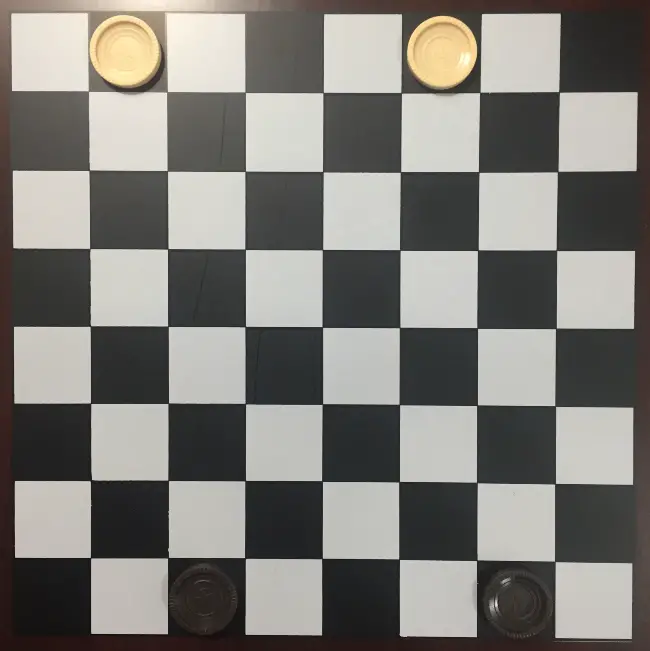
The main thing is not to be afraid of moving a back row piece, but to do it with purpose. Staying flexible will allow you to make a strong move. More possibilities for the back row are dealt with in the next section.
Checkers Strategy: Maintaining a Strong Formation
Another easy way to improve your game is learning to maintain a strong formation. A part of this is advancing your pieces together without leaving gaps, which make you vulnerable to being jumped.
Checkers Pyramid Strategy
Here’s a strong formation, the pyramid, that you can try using.
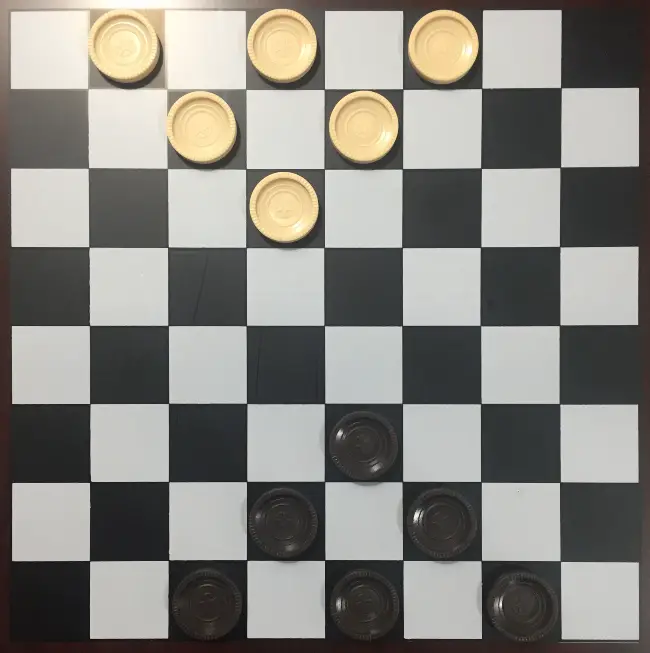
One of the great things about the pyramid is that it’s a part of the initial board setup—you don’t have to move anything to achieve it. You just have to refrain from moving these 6 pieces as long as you reasonably can. When you have to break it up, then you can maintain the smaller 3 piece triangle on the left side as long as you can.
Another general principle related to formation is to develop your single corner side (the left side where there’s a black square right in the corner) and keep your double corner side (the right side where there are 2 black squares next to the corner) intact. You can see that the pyramid formation works well with this principle, as the single corner pieces have been moved out.
Checkers Strategy: A Strong Opening Move
For black, the strongest opening in checkers is moving the single corner middle piece toward the center. If you’re playing the white pieces and your opponent makes this move, the best response is moving the single corner middle piece toward the side. Getting used to playing these moves will get you off to a good start. Here’s what they look like:
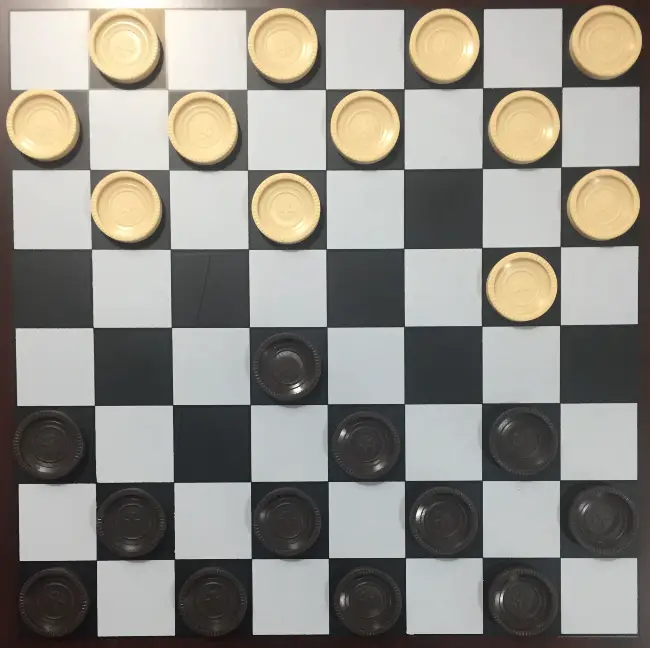
The weakest of all the 7 possible opening moves should definitely be avoided, which is moving the double-corner end piece to the side. Amateurs like this move because it feels safe to advance against the edge where you can’t be jumped. If your opponent makes this move, the best response is moving the single corner middle piece toward the center, which you’ll notice is the equivalent of black’s strongest opening. Here’s what these moves look like:
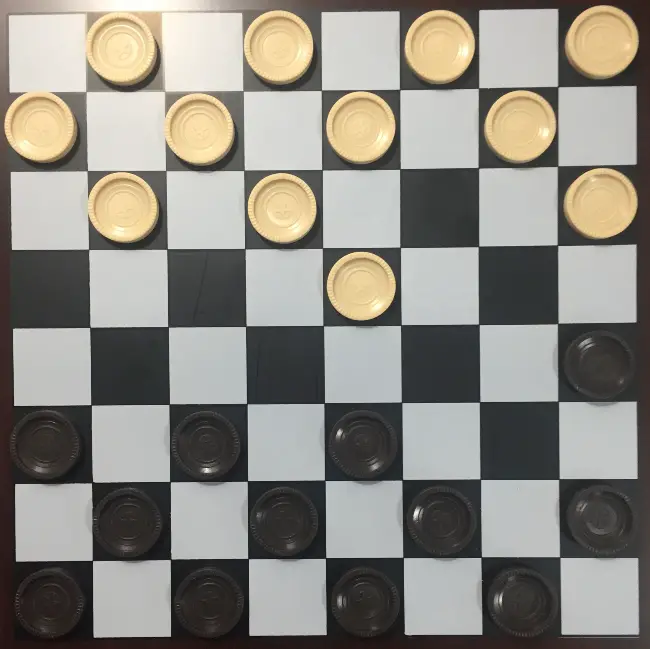
How to Win Checkers: Tactics
Checkers Tactic: The 2 for 1
The most important tactic in checkers is learning how to exchange 1 of your pieces for 2 of your opponent’s. For beginners, these situations are just pleasant surprises, but you can set them up intentionally.
Here’s an example where black can give up 1 piece and get 2 back. The first picture shows a 3 on 3 situation. In the second picture, black advances the pawn shown, forcing white to jump it, resulting in the position in the third picture.
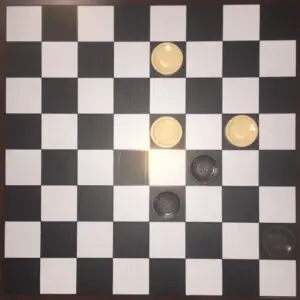
Black now has a double jump on the 2 white pieces on the right side of the board, and is on the way to an easy win.
Checkers Tactic: The 3 for 2
Giving up 2 pieces to capture 3 is a similar tactic and will often come about in the same ways. Here’s a 3 on 3 situation with lots of potential for black.
Black moves the pawn shown in the second picture, forcing white to jump, as shown on the board below.
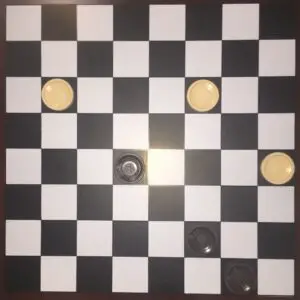

Black now moves another pawn, forcing white to jump again, giving us the position on the final board.
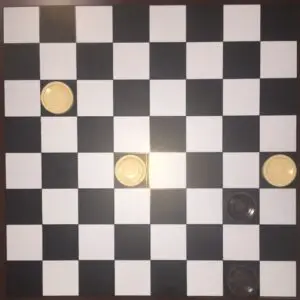
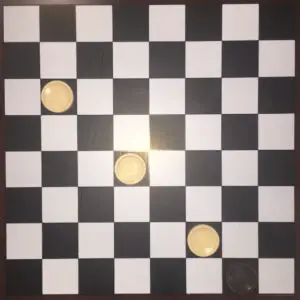
After giving up 2 pieces, black now has a game ending triple jump.
Notice that black must force white to jump in the order show. If black forces the second jump first, black would then be forced to jump white before the triple has been set up.
Checkers Tactic: Attacking Groups of 3
Look for opportunities to remove the center piece when your opponent has 3 pieces in a row. The first picture shows an example where black has 3 pieces lined up. White moves as shown in the second picture, forcing black to jump. The resulting gap leaves its pieces vulnerable.
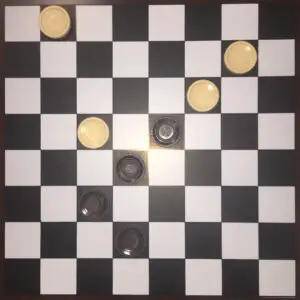
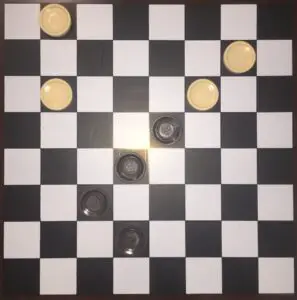
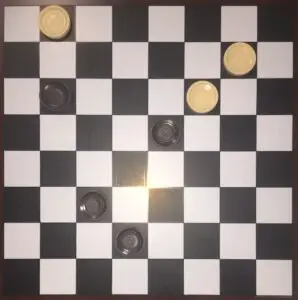
White now has a double jump, easy king, and is on its way to winning.
As you play more and pay attention, you’ll start recognizing the patterns that can lead to multiple jumps, which will make you much harder to beat.
How to Win Checkers: Tips
Paying Attention to Forced Moves
The fact that checkers has a mandatory capture rule is what leads to many of the great jumping combinations that are possible. Pay attention to the chances you have to force your opponent to jump you. What will the board look like then? Drawing your opponent to new squares by giving up a piece or two might create a double or triple jump position for you.
If the result will simply be 1 for 1 or 2 for 2, will the new position be advantageous for you or not? If an even exchange leaves you with a stronger formation, take it.
Keep Thinking
Don’t just think about your move when it’s your turn. Instead of relaxing after you move, keep thinking about the position.
- Where is your opponent the strongest and weakest?
- Where are you the strongest and weakest?
- Look for opportunities to set up multiple jumps or strengthen your formation.
There’s a lot to explore and learn in this great game. Keep playing and have fun!
I hope this look at checkers strategy & how to win checkers has been helpful. Applying these checkers strategies, tactics, tips & tricks will have you winning in no time!
